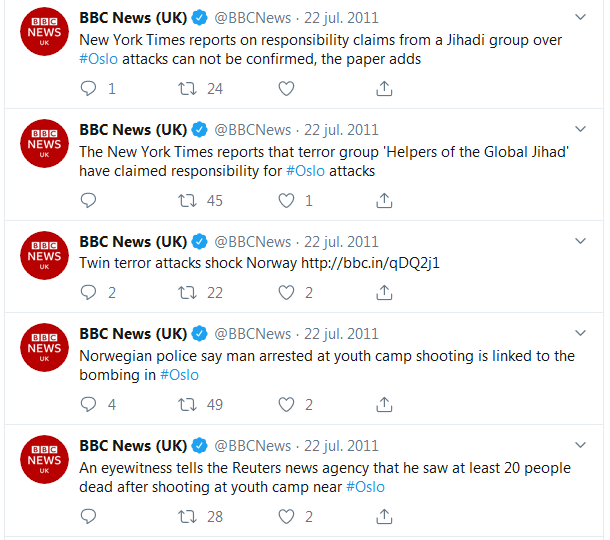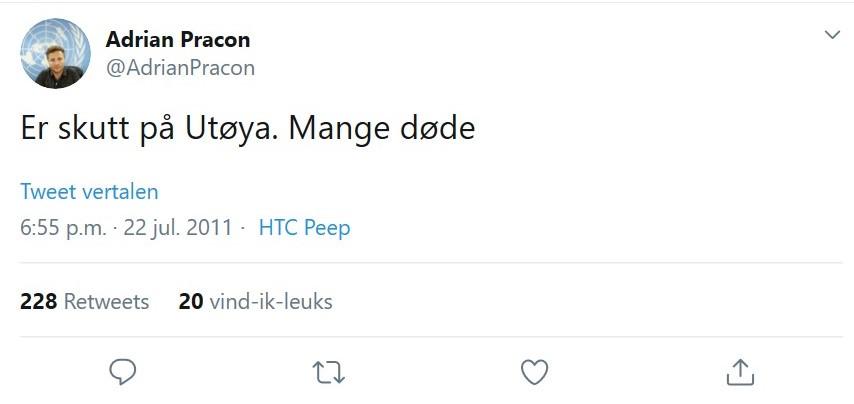
BREAKING: 'Devastating Al-Qaeda attacks in Norway'
The car bomb that exploded at the Norwegian government’s headquarters in Oslo on the 22nd of July 2011 did not only shake the country, but the entire world. Even though the exact nature of the grim event that caused war-like scenes were not immediately clear, various national and international media producers began to report about it. Their broadcasts involved on-site reporters, eager opinions of experts speculating real-time about the possible perpetrator of the attack and showed footage of previous Muslim attacks. Was this attack committed by Muslim terrorists? Was Al-Qaeda behind this? And, why was ‘peaceful’ Norway the target of such violence?
The shootings at the Labour Party youth summer camp on the Norwegian island Utøya that happened shortly after the Oslo attack raised even more speculations about foreign terrorism. Police later debunked these guesses as they announced that both attacks were committed by the same individual, a ‘tall, blonde, Norwegian-looking man’ named Anders Behring Breivik (Nuyten et al., 2014) who killed 77 and injured over 200 individuals on that fatal day (Wang, 2016). Examining various accessible media reports about the Norway attacks, this paper looks through the lens of the ‘breaking news’ phenomenon to investigate the ways experts affect the curation of the incidents’ facts whilst acknowledging the times in which we live, in which digitization, factual accuracy and the audience’s expectations for rapid news reporting have significant roles.
The 'Breaking News' format
Contemporary journalism, a form of mediatization in which news media produce reports 24/7 and use audience contributions, is widely adopted in the current media landscape. As diverse news items are rapidly available in the hybrid media system, immediate reporting becomes possible. Implicitly, news media prioritize their own ideas about what is important and are thus biased, a phenomenon recognizable through language use. Their statements are never completely objective and always involve intonations, linguistic choices and the provision of selected background details. “Rather than offering value-free representations of the world, news language invariably reflects particular worldviews, interests, and ideas about society” (van Hout & Burger, 2015, p2). Not only the media report in contemporary journalism: the public has “joined the actors on the stage and talk back, repurpose content, share news stories and create their own” (van Hout & Burger, 2015, p3). This interaction enables even more speculation, fake news and unwelcome opinions and statements; each easily spread in today’s digital landscape and enhanced as ‘breaking news’.
“Rather than offering value-free representations of the world, news language invariably reflects particular worldviews, interests, and ideas about society” (van Hout & Burger, 2015)
In presenting news, mass media employ specific formats that are repeated constantly to create a recognisable and clear effect with the target audience (Blommaert, 2017). The ‘breaking news’ format is used to present and create ‘big news’, such as the carnage in Norway. Its first characteristic is the interruption of regular programmes by a non-stop, real-time, constantly repeated report of the already-known facts that is further supported by interventions of reporters and (eye)witnesses who are oftentimes at the incident’s location or provide digital imagery of it (Blommaert, 2017). This also occurred on 22 July, as the editorial offices rapidly became active after the explosion in Oslo at 3.26pm. The Norwegian national news broadcaster NRK started broadcasting on television 35 minutes after the attack and continued reporting for 36 hours straight (Nuyten et al., 2014). Soon after the impact of the incident became clear, television broadcasters in many other countries interrupted with extra news updates and the news further spread on radio, Twitter and live blogs.
A further characterization of breaking news is its intention to create an ‘event’ by using lots of airtime and large amounts of tiny bits of information. Even though the audience is hardly informed, the news has to be exciting and journalists should provide the audience with a constant intense experience of emotional engagement (Blommaert, 2017). Feeding this sentimental involvement, many news platforms, whether on television, such as NOS news, or online, such as BBC news, repeatedly broadcasted a specific amateur video showing the Oslo bombing aftermath which included the damaged buildings, dust and debris, people running and wounded individuals. Later, footage taken from a 'news helicopter' circling Utøya with shaky footage showing the island, tents, bodies, and several youths swimming away from the island was added to this repetition-reel.
Amateur video footage in BBC's broadcast
Defining the expert
In the discourse of speculations and curating facts, media oftentimes invite ‘experts’ to elaborate on patterns and motives in particular incidents. Deriving from the Latin term expertus, an expert is a person ‘having, involving, or displaying special skills or knowledge derived from training or experience’ (Merriam-Webster, 2019). Their role in news reports is then to provide a specialized analysis or specific background information on a certain topic, providing information or insights that any ‘regular’ person would not know. A paper on the BBC’s Norway incidents live blog classified experts as ‘official sources and authorized knowers’, a group accounting for a third of the blog's sources. Interestingly, eyewitnesses are regarded as ‘non-official’ sources, even though they can oftentimes provide more valuable information than reporters themselves (Bennett, 2016).
The role of experts in the 22 July attacks
In reports of the 2011 Norway attacks, many experts appeared on various media platforms, mainly attempting to identify the perpetrators and possible motives. Taking Dutch television as an example, the daily news program EenVandaag invited Bibi van Ginkel, expert in combating terrorism and preventing radicalization in international contexts (Clingendael, n.d.). As the broadcast aired between 6.15pm and 6.30pm, when the shooting at Utøya was still unknown (the incident’s first reports came in at 6.27pm), she only discussed the bombing in Oslo (EenVandaag, 2011).
After an introduction and the host’s factual announcement of the bombing, he asked van Ginkel ‘any ideas which direction to look in when thinking about the perpetrator?’. She responded swiftly with ‘‘in the first instance everyone obviously always thinks about Al-Qaeda’’, after which she connected the Oslo incident to previous attacks performed by this group. She mentioned the occurrence of several arrests in Europe, including Norway, of individuals who were part of a ‘greater terrorism network’, insinuating that the Oslo attack could be committed by ‘‘the Al-Qaeda network or people inspired by Al-Qaeda’’ (EenVandaag, 2011). The expert speculated about the presence of a few 100 Norwegian soldiers in Afghanistan, Norway being one of the few NATO-partners who participated in bombings in Libya, and the state’s case against Mullah Krekar, founder of Islamic rebel group Ansar Al-Islam as causes for the Oslo attack.
When van Ginkel reappeared on EenVandaag the following day she was asked whether she was surprised the perpetrator was not Al-Qaeda but a Norwegian extreme-right lone wolf. She replied ‘well yesterday we thought that because of the type of attack and its complexity that we could potentially speak of Al-Qaeda, there were several clues’. And even though van Ginkel was not aware of the Utoya-shootings at the time, it was remarkable that she had maintained such strong confidence in what turned out to be a mistaken hypothesis.
‘‘Yesterday we thought that because of the type of attack and its complexity that we could potentially speak of Al-Qaeda, there were several clues’’
This example illustrates ‘the intraprofessional news interview’ format, a “widely used format in broadcast news of interactions between a news anchor and a fellow journalist in the role of expert. The interviewer enhances rather than questions the interviewee’s authority” (van Hout & Burger, 2015, p5). As the host fed the dialogue by responding to van Ginkel’s sole focus on motives for an Islamic terrorist attack, he provided her with this sense of authority. And, as he did not direct their attention to any other direction, he consequently joined in the bias their conversation ultimately presented. This frame causes the expert’s knowledge to remain unquestioned by the audience or other news media, as it is regarded as believable and reliable.
The spread of a fake news tweet
Also involved in the Oslo speculations was expert William McCants, a terrorism and extremism analyst (Brookings, n.d.). At 18.06 he tweeted that the bombing attack had been claimed by Islamic terrorist group Ansar Al-jihad Al-Alami (Jihadica, n.d.), but he lacked hard evidence to back his statement up. Regardless, the claim got picked up by media all around the globe, including high-end platforms such as the New York Times and the BBC. Shortly after, McCants deleted his tweet and denied his initial claim that there was an official terrorists’ statement. This was to no avail as the message has already spread globally due to the power of social media (Gentile, 2011).

BBC News referring to The New York Times who picked up McCants' claim
Remarkably, both of these experts risked worsening the situation by immediately interpreting the Oslo attack as Islamic terrorism without having any hard proof. Even though possible reasons for the attack as an act by Al-Qaeda existed, they risked damaging the audience’s trust in media with potential misinformation, and jeopardized the Muslim community.
The 'real experts'
As it appears that the experts could not provide novel facts, it is interesting to note how the expressions from ‘experience witnesses,’ or eyewitnesses, were not heavily addressed in news reports. Especially during the shooting on Utøya, the incident that intensified disbelief as the news helicopter that circled the island filmed a ‘man in police uniform’ on a rampage, media remained reluctant to divert their gaze from Islam even though tweets with evidence coming directly and real-time from victims were publicly available.
Only after the police captured the Norwegian perpetrator, media started to show testimonies of experience witnesses to their audiences to support of their new reports, this time focussing increasingly on Breivik’s actions. Even though the first-hand experts did provide new facts, media adopted these when it was too late and could merely use these expressions for emotional engagement or further analysis. It is appealing to argue that media have a certain sense of selfishness, presenting the information they think is the likeliest truth at a high cost. For example, the previously mentioned news helicopter, firstly did nothing to aid the victims and just gathered footage for the media's own use, and secondly could have provided crucial facts by being more aware as they filmed Breivik in action, but only discovered this much later (New York Times, 2011).
The 'Muslim-terror' format and audience biases
The Islam-focussed tunnel vision of experts and media evokes a specific worldview within the audience, especially as it gets repeated on all channels. This narrowed vision in itself is a format that could be referred to as the ‘Muslim-terror format’. Oftentimes when there is an incident and consequentially the need to immediately provide some kind of shape and tone to it, the event is squeezed into this frame as it is processed in the newsroom.
Recurring since 9/11, this format follows a script that constitutes a form of political correctness by deciding which moralized behaviour is the sole appropriate public response for such incidents. In turn this covers up the politically intensified racism and Islamophobia and distracts from the guilt-by-association against the entire Muslim population that is occuring (Blommaert, 2016).
Because of various prior attacks, the ‘Muslim-terror’ format has become widespread and constantly ready-at-hand to be applied to any new uncertain incident. As the structure of news reporting is ‘the only window through which people ‘know’ such phenomena’ and media is thus perceived as truthful and reliable, the format is key to the audiences’ biases (Blommaert, 2016).
A significant consequence of these biases is ‘othering’, the division of society in which a dominant group, ‘us’, identifies another, and inferior group as ‘other’ (Staszak as cited in Planken, 2016). In the ‘Muslim-terror’ format, and thus the representations of Islam in Western media, ‘othering’ occurs for instance when solely that religion is portrayed as a cause for spreading terror (Kumar as cited in Planken, 2016). As ‘other’, the Islam is then frequently associated with negative characteristics and events that do not fit Western society, which in turn continues to feed the audiences’ beliefs and biases.
As the media that covered the Norway attacks worked through the ‘Muslim-terror’ format they tapped into audiences’ biases about Islam, which made it, for Norwegians, impossible to believe that it was someone from their own group who had committed the attacks; how could it have been someone from within ‘us’?
Must we reconsider breaking news?
There are many elements to a breaking news item, and it is up to the media to decide how they curate their reports using these elements. In the age of digitization and mediatization news needs to be rapid, but it is difficult to construct a truth without hard facts. Thus, news media constantly repeat the information they do have and use the opinions of experts to generate trust with their audience. This, however, results in speculations beyond facts as experts tend to discuss incidents from their, often biased, perspective which is then further backed by the media’s use of a ‘Muslim-terror’ format. The reporting on the 2011 Norway attacks we analyzed provides a clear example of this discriminatory coverage, as besides giving some valuable background information they kept a focus on Al-Qaeda and Islam whilst there were other options to look at, and witnesses who proved otherwise.
Even though it is important to keep in mind that the above analysis is rather limited, as there is a much larger archive of real-time media-data on the Norway attacks that would require further analysis, some things did become clear about the way media deal with breaking news. On the one hand, the audience needs to understand that speculation is difficult to avoid as new information is constantly craved for and news media are attempting to still this hunger by presenting and constructing potential facts within a certain frame. And individuals should always remain vigilant, critical and engage in fact-checking and analyze the information that is presented to them. On the other hand, news media themselves need to carefully consider the consequences of releasing unproven facts and information, and should wait for the truth rather than making an incident worse that is already bad, and lose the audience’s trust. Media should furthermore be more aware of which frames they construct and what content is broadcasted to prevent negatively biasing their audience, and to avoid ‘othering’.
References
Bennett, D. (2016). Sourcing the BBC’s Live Online Coverage of Terror Attacks. Digital Journalism, 4(7), 861–874. https://doi.org/10.1080/21670811.2016.1163233
Blommaert, J. (2017). Groot nieuws: een vliegtuig landt! Diggit Magazine.
Blommaert, J. (2016). The 9/11 format and its consequences. Ctrl+Alt+Dem.
British Broadcast Channel. (2011). ‘Eighty dead’ in Norway shootings. BBC News.
Brookings. (n.d.). Personal profile William McCants. Brookings Institution.
Clingendael. (n.d.). Personal profile Bibi van Ginkel. Clingendael Netherlands Institute of International Relations.
Diggit Magazine. (2019). Hybrid media system. Wiki.
EenVandaag. (2011, July 22). Doden bij aanslag Oslo. [News broadcast]. Netherlands: AVROTROS.
Eenvandaag. (2011, July 23). Dader Oslo nachtmerrie van elke overheid. [News broadcast]. Netherlands: AVROTROS.
Gentile, S. (2011). Portrait of ‘right-wing’ suspect in Oslo attacks emerges as ‘Jihadist’ link is debunked. PBS.
van Hout, T., & Burger, P. (2015). Mediatization and the language of journalism. Tilburg Papers in Culture Studies, 131.
Jihadica. (n.d.). About.
Merriam-Webster. (2019). Definition of expert.
New York Times. (2011). World: Survivors of Utoya Island - nytimes.com/video. [YouTube].
Nuyten, B. (director), Mansell, F. (director), Somer, M. (producer) & Josten, M. (editor). (2014). 2Doc Medialogica: The usual suspects. [Documentary]. Netherlands: Human/VPRO.
Planken, B.M. (2016). Ben ik dat?! Moslims en de Islam: beeldvorming in de media. [Thesis].
Pracon, A. (2011). Adrian Pracon on Twitter. Twitter.
Wang, Y. (2016). Anders Breivik, killer of 77, convinced a Norwegian court his human rights were violated. The Washington Post.
